Fady and the Aye-aye
Aye-ayes (Daubentonia madagascariensis) have been described by countless scientists as the most unique primate. Like all lemurs, these highly adapted solitary and nocturnal primates are only found on the island of Madagascar. After their introduction to western scientists in 1782 by Pierre Sonnerat, exactly what aye-ayes are became a topic of debate for over a hundred years. Initially classified as a rodent by western scientists, aye-ayes were subsequently classified with tarsiers, bushbabies, and even kangaroos, before reaching their rightful taxonomic placement with lemurs in 1866.
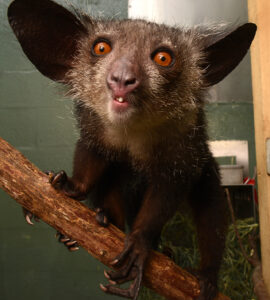
Aye-aye are highly unusual looking primates with many specialized adaptations.
The aye-aye’s incredibly unique adaptations include a thin, flexible “tapping” finger on each hand, bat-like ears, and ever-growing, rodent-like incisors (rather than the characteristic lemur toothcomb). The combination of their unique adaptations allow the aye-aye to access one of its favorite food sources, wood-boring insect larvae, through ”percussive foraging” – for more information on this amazing behavior, check out video 12 of our Virtual Tour: “Aye-ayes!” In addition to insect larvae, aye-ayes love to eat fruit, traveler’s palm nectar (Ravenala madagascariensis), gall-like growths on trees, coconuts and mangos from cultivated fields, and seeds from the ramy tree (Canarium madagascariensis) – these are a great favorite, making up a significant portion of the wild aye-aye diet.
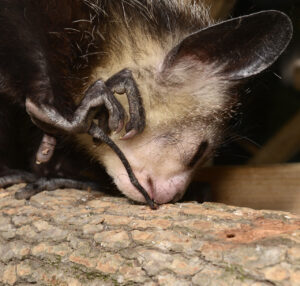
An aye-aye uses its tapping finger to look for bugs in an old log.
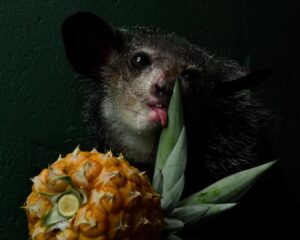
Lucrezia investigates a pineapple provided by her keeper.
As highly adaptable creatures, aye-ayes can be found along the forested edges of Madagascar, from the western dry forests around the edge of the island, through the north and eastern rainforests, down to the southeastern forests. Despite this, aye-ayes have a rather low population density due to their solitary nature. They have the largest ranges when compared to lemurs of similar size: 0.11-0.15 square miles for females and 0.5-1 square mile for males (who are believed to travel more to find the females).
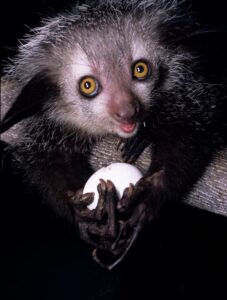
Aye-ayes at the Duke Lemur Center receive soft-boiled eggs as part of the daily diet rotations.
Where the aye-aye got its name is uncertain. Some argue that it came from the response of the local Malagasy people when asked what the animal was. Aye-aye in Malagasy sounds like hai-hai which can be translated to “I don’t know.” It is unlikely that the people truly didn’t know, since aye-ayes are referred to by the same name across the island’s many different dialects, but the “hai-hai” response may have been due to local superstition – fear of the name growing out of fear of the animal itself. Fady or taboos are a central part of Malagasy culture, and while the majority of fady are positive, the most notable negative fady concerns aye-ayes.

While most aye-ayes at the Duke Lemur Center are named for dark, mysterious characters and authors. Fady is named for the taboos in Madagascar.
Due to the incredible ethnic and cultural diversity present in Malagasy culture, fady are not universal across the island, but there are three main types. Sandrana are the strictest fady – never to be broken for fear of supernatural retribution. Fadin-drazana are fady that have been invoked by the ancestors – these are negotiable and can be broken in times of need. The last type, fadim-piarahamonina, are fady of the community – the least strict, these are determined by what is accepted by society.
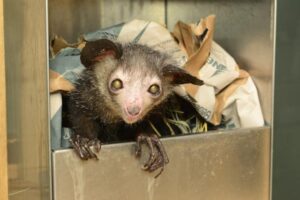
Endora peeks out of her nest box before her lights turn off for the “day”. At 37, Endora is the oldest aye-aye in human care.
Other typical fady include only harvesting certain types of crops on certain days of the week or using the proper technique to harvest palm fronds for weaving. In many Malagasy communities, aye-ayes are considered harbingers of death, causing death in the village when spotted by a resident. Fady dictates that an aye-aye spotted during the day (a thankfully rare occurrence) must be killed and placed along the road, then when a stranger passes, the ill fortune leaves the village with them.

Younger aye-ayes like Melisandre are exceptionally playful and very curious.
One of the most widespread fady in Madagascar states that forests surrounding burial grounds are sacred and may not be disturbed. These areas often contain ramy trees, whose nuts form a central part of the wild aye-aye diet. Though the origin of the aye-aye fady is not known, their strange appearance, solitary ways, and occasionally tendency to venture into sacred burial areas certainly do not discourage their spooky reputation.
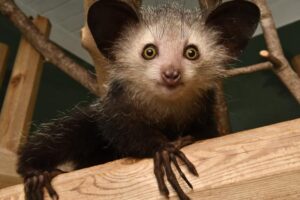
If you look closely, you can see the unique tapping finger on Agatha’s hand.
Though these practices may sound strange at first, people around the world follow their own cultural, familial, or individual fady every single day. Consider some of the fady many of us believe in the United States: don’t let a black cat cross your path, or break a mirror, or walk beneath a ladder, or open an umbrella inside, lest you invite bad luck to follow. These cultural taboos and beliefs affect human attitudes toward wildlife around the world, creating unique challenges for conservation efforts as close to home as rural North Carolina, or as far across the world as the island of the lemurs.
If you’d like to learn more about aye-ayes or fady in Madagascar, we recommend checking out our sources for this article:
Edward E. Jr. Louis (Madagascar Biodiversity Partnership, H., Brigitte Raharivololona (University of Antananarivo, M., Timothy Sefczek (Center for Conservation and Research, O., Doménico Randimbiharinirina (Mention Anthropobiologie et Développement Durable, É, Jeannin Rakotondrazandry (Université de Mahajanga, M., Diane Manjary (Unknown – lemurs – Madagascar), . . . Faranky Ravelomandrato (Unknown – lemurs – Madagascar). (2018, May 07). The IUCN Red List of Threatened Species. Retrieved September 30, 2020, from the IUCN .
Golden, C. D., & Comaroff, J. (2015). Effects of social change on wildlife consumption taboos in northeastern Madagascar. Ecology and Society, 20(2), 1-10.
Jones, J. P., Andriamarovololona, M. M., & Hockley, N. (2008). The Importance of Taboos and Social Norms to Conservation in Madagascar. Conservation Biology, 22(4), 976-986. doi:10.1111/j.1523-1739.2008.00970.x
Lambek, M. (1992). Taboo as Cultural Practice Among Malagasy Speakers. Man, 27(2), 245-266.
Mittermeier, R. A., & Nash, S. D. (2010). Family Daubentoniidae. In Lemurs of Madagascar (pp. 597-609). Arlington, VA: Conservation International.
Osterhoudt, S. R. (2018). Community Conservation and the (Mis)appropriation of Taboo. Development and Change, 49(5), 1248-1267. doi:10.1111/dech.12413
Oxnard, C. E. (1981). The Uniqueness of Daubentonia. American Journal of Physical Anthropology, 54, 1-21.
Quinn, A., & Wilson, D. E. (2004). Daubentonia madagascariensis. Mammalian Species, 740, 1-6. doi:10.1644/740
Simons, E. L. (2001). Folklore and Beliefs about the Aye aye (Daubentonia madagascariensis). Lemur News, 6, 11-16.
Sterling, E. (1994). Taxonomy and Distribution of Daubentonia: A Historical Perspective. Folia Primatologica, 62(1-3), 8-13. doi:10.1159/000156758

